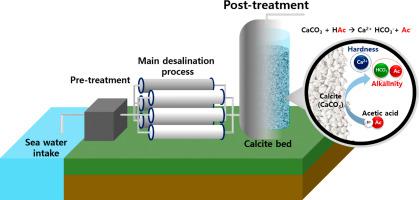Desalination ( IF 9.9 ) Pub Date : 2021-07-09 , DOI: 10.1016/j.desal.2021.115227 Yu Chang Kim 1 , Hongsik Yoon 1

|
Post-treatment is essential to ensure hygienic desalinated water, and to prevent pipe corrosion. Calcite dissolution technologies are used to re-mineralise desalinated water via reverse osmosis, to enhance the calcium (i.e., hardness) and alkalinity concentrations therein. Sulphuric or carbonic acid is typically used for calcite dissolution but acetic acid can be exploited in small-capacity desalination plants. Of course, ultraviolet (UV) disinfection is an essential prerequisite because UV treatment does not contribute to the formation of disinfection byproducts (DBPs). Accordingly, we propose a specified acidification method that exploits acetic acid to optimise both the calcium and alkalinity concentrations via calcite dissolution. The process meets the regulatory standards for the calcium and alkalinity concentrations, and pH, of desalinated water. We found that acidification with strong acids (e.g., sulphuric or hydrochloric acid) yielded inappropriate calcium:alkalinity ratios. Calcite dissolution by acetic acid exhibited excellent dissolution kinetics, resembling those obtained using strong acids. We expect that our specified acidification method will facilitate calcite dissolution in small-capacity desalination plants.
中文翻译:

醋酸用于小容量海水淡化厂方解石溶解的开发
后处理对于确保脱盐水的卫生和防止管道腐蚀至关重要。方解石溶解技术用于通过反渗透使淡化水再矿化,以提高其中的钙(即硬度)和碱度浓度。硫酸或碳酸通常用于方解石溶解,但乙酸可用于小容量海水淡化厂。当然,紫外线 (UV) 消毒是必不可少的先决条件,因为紫外线处理不会导致消毒副产物 (DBP) 的形成。因此,我们提出了一种特定的酸化方法,该方法利用乙酸通过方解石溶解来优化钙和碱度浓度。该过程符合钙和碱度浓度以及 pH 值的监管标准,淡化水。我们发现用强酸(例如硫酸或盐酸)酸化会产生不适当的钙:碱度比。醋酸溶解方解石表现出优异的溶解动力学,类似于使用强酸获得的溶解动力学。我们预计我们指定的酸化方法将促进小容量海水淡化厂的方解石溶解。



























 京公网安备 11010802027423号
京公网安备 11010802027423号